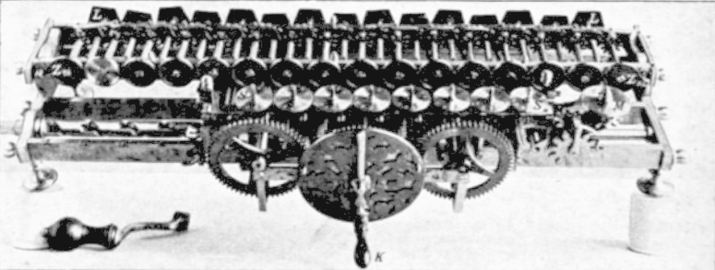Calculus ratiocinator
This article includes a list of general references, but it lacks sufficient corresponding inline citations. (May 2010) |
The calculus ratiocinator is a theoretical universal logical calculation framework, a concept described in the writings of
Two views
There are two contrasting points of view on what Leibniz meant by calculus ratiocinator. The first is associated with
Analytic view
The received point of view in
Synthetic view
A contrasting point of view stems from
"The history of the modern computing machine goes back to Leibniz and Pascal. Indeed, the general idea of a computing machine is nothing but a mechanization of Leibniz's calculus ratiocinator."
— Wiener (1948, p. 214)
"...like his predecessor Pascal, [Leibniz] was interested in the construction of computing machines in the Metal. ... just as the calculus of arithmetic lends itself to a mechanization progressing through the abacus and the desk computing machine to the ultra-rapid computing machines of the present day, so the calculus ratiocinator of Leibniz contains the germs of the machina ratiocinatrix, the reasoning machine."
— Wiener (1965, p. 12)
Leibniz constructed just such a machine for mathematical calculations, which was also called a "stepped reckoner". As a computing machine, the ideal calculus ratiocinator would perform Leibniz's integral and differential calculus. In this way the meaning of the word, "ratiocinator" is clarified and can be understood as a mechanical instrument that combines and compares ratios.
-
Internal mechanism of the stepped reckoner
-
Contemporary replica of the stepped reckoner
A classic discussion of the calculus ratiocinator is that of Louis Couturat,[3] who maintained that the characteristica universalis — and thus the calculus ratiocinator — were inseparable from Leibniz's encyclopedic project.[4] Hence the characteristics, calculus ratiocinator, and encyclopedia form three pillars of Leibniz's project.
See also
References
- ^ Fearnley-Sander (1982), p. 164.
- ^ Rogers (1963), p. 934.
- ^ Couturat (1901), chapters 3, 4.
- ^ Couturat (1901), chapter 5.
Bibliography
- Couturat, Louis (1901). La Logique de Leibniz. Translated by Rutherford, Donald. Paris: Felix Alcan. Archived from the original on 2012-08-14.
- .
- S2CID 28452205.
- The MIT Press.
- Fearnley-Sander, Desmond (1982). "Hermann Grassmann and the Prehistory of Universal Algebra". .


